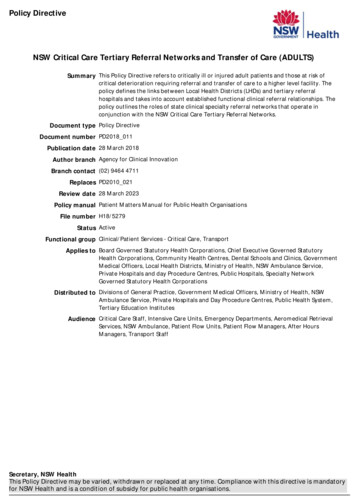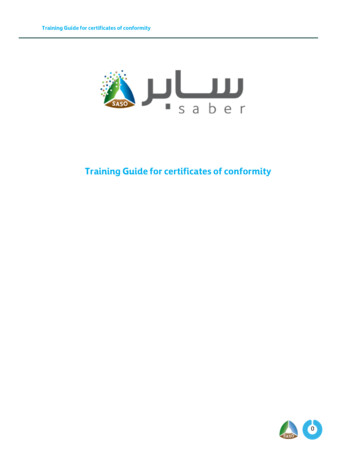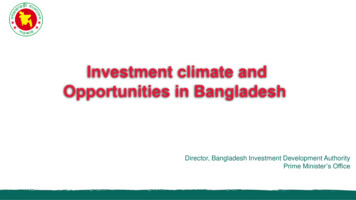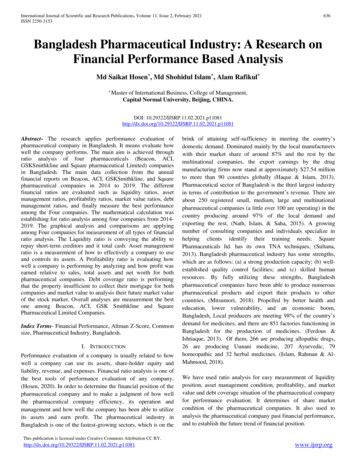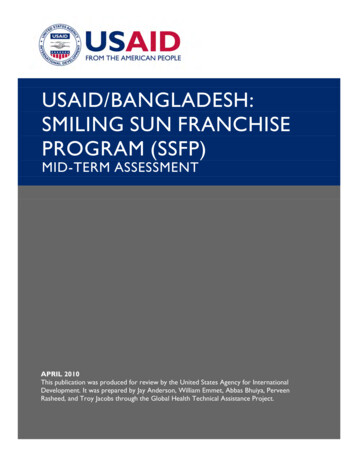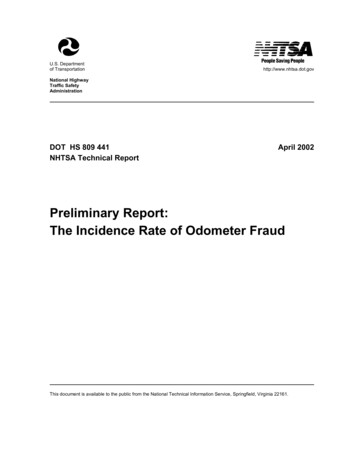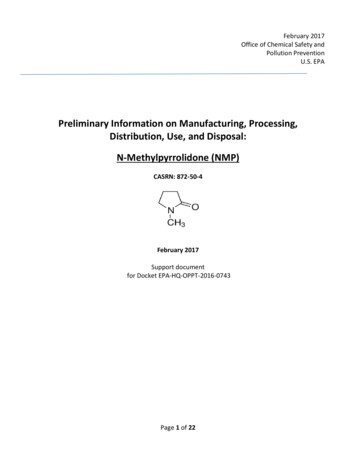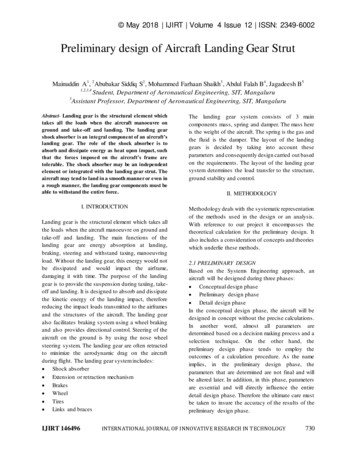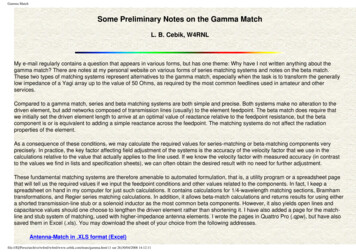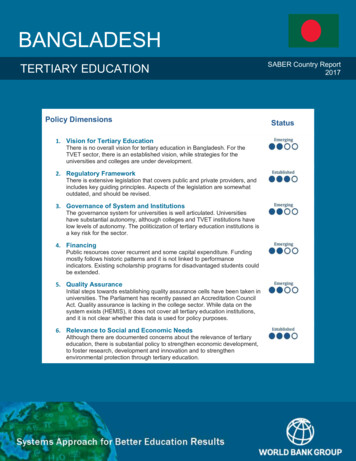
Transcription
BANGLADESHTERTIARY EDUCATIONPolicy DimensionsSABER Country Report2017Status1. Vision for Tertiary EducationThere is no overall vision for tertiary education in Bangladesh. For theTVET sector, there is an established vision, while strategies for theuniversities and colleges are under development.2. Regulatory FrameworkThere is extensive legislation that covers public and private providers, andincludes key guiding principles. Aspects of the legislation are somewhatoutdated, and should be revised.3. Governance of System and InstitutionsThe governance system for universities is well articulated. Universitieshave substantial autonomy, although colleges and TVET institutions havelow levels of autonomy. The politicization of tertiary education institutions isa key risk for the sector.4. FinancingPublic resources cover recurrent and some capital expenditure. Fundingmostly follows historic patterns and it is not linked to performanceindicators. Existing scholarship programs for disadvantaged students couldbe extended.5. Quality AssuranceInitial steps towards establishing quality assurance cells have been taken inuniversities. The Parliament has recently passed an Accreditation CouncilAct. Quality assurance is lacking in the college sector. While data on thesystem exists (HEMIS), it does not cover all tertiary education institutions,and it is not clear whether this data is used for policy purposes.6. Relevance to Social and Economic NeedsAlthough there are documented concerns about the relevance of tertiaryeducation, there is substantial policy to strengthen economic development,to foster research, development and innovation and to strengthenenvironmental protection through tertiary education.TTHETHHE WOWWORLDORLRLD BANKBANKBANK
BANGLADESH ۣ TERTIARY EDUCATIONSABER COUNTRY REPORT 2017IntroductionSABER-Tertiary Education is a diagnostic tool to assess how education systems perform and to identifypriorities for reforms at the national level. It is part of the World Bank’s Systems Approach for BetterEducation Results (SABER), which aims to benchmark education systems at the country level.SABER-TE focuses on six dimensions of tertiary education policy(see Box). The general idea is that a strong policy environment is aprerequisite to better-performing tertiary education institutions,including universities, colleges, and technical and vocationalinstitutes. The diagnostic tool aims to help countries assess bestpractices, and to diagnose which policies need urgent attention.For some policy areas, countries are scored on specific “policylevers” to help make concrete recommendations forimprovement.Each of the six policy dimensions can contribute to the outcomesof tertiary education systems, although they work together in aholistic way. By matter of illustration, a vision without an effectivegovernance structure is just a collection of ideas that will not beimplemented; a well-designed governance structure without avision is a meaningless bureaucracy.Six policy dimensions of successfultertiary education systems (WorldBank 2016):1.2.3.4.5.6.A strong vision for tertiaryeducationA clear regulatory frameworkModern governance anduniversity autonomyFinancing that promotesperformance and equityIndependent quality assuranceRelevance to the country’ssocial and economic needsThe World Bank has identified best practices in each of these dimensions in a review of the world’s mosteffective tertiary education systems (World Bank 2016). The best practice indicators used for scoring aremade available in the appendix of this report. Countries are scored and then benchmarked on these policydimensions with four different scores:1.2.3.4.Latent: this topic has received too little attention;Emerging: there are some instances of good practice;Established: there is systemic good practice; andAdvanced: the country follows international best practice and is an example for others.SABER uses an extensive questionnaire to collect data on the policy environment for tertiary education.The questionnaire is populated through an analysis of the most recent versions of relevant legislation,policy documents and reports on the sector. The SABER team also carried out fieldwork in Bangladeshbetween March 4 and 17, 2017 with visits to several universities, government agencies, and otherstakeholders. After data collection is complete, the policy dimensions are scored on a rubric (see Appendix1 for a full overview of the rubric). Both the answers to the questionnaire and the rubric scores areavailable from the SABER website (http://saber.worldbank.org).This report proceeds as follows. First, we describe the context of the tertiary education system inBangladesh. We then proceed with scoring the six policy dimensions with descriptions followed by aconclusion with a few general observations about tertiary education in Bangladesh.SYSTEMS APPROACH FOR BETTER EDUCATION RESULTS2
BANGLADESH ۣ TERTIARY EDUCATIONSABER COUNTRY REPORT 2017ContextBangladesh faces an optimistic scenario in terms of social and economic development. It is one of theworld’s most populous countries with an estimated 160 million people. The country has the tenth highestpopulation density in the world, with 1,237 individuals per square kilometer of land area (World Bank2015a). With a per capita income of US 1,409 in 2016, it is well above the threshold for lower-middleincome countries. In recent years, driven by manufacturing and services, its GDP rose by 6.5 percent onaverage since 2010, with an officially reported growth rate of 7.05 percent in the 2016 fiscal year. Progresshas continued to be made in reducing extreme poverty and boosting shared prosperity through humandevelopment and employment generation. Poverty incidence 1 declined from 44.2 percent in 1991 to 18.5percent in 2010 (latest available poverty data) and is projected to have further declined to 14.9 percentin 2016. Bangladesh’s performance against the Millennium Development Goals (MDG) is impressivecompared with that of other countries in the South Asia Region on most indicators.In this context of growth, it is no surprise that Bangladesh’s tertiary education system is growing quicklyand is already vast (see Table 1). The total number of students in tertiary education reached 2.84 millionin 2015, up from 1.60 million in 2010 (BANBEIS 2016). At current rates, the share of the youth populationwith a tertiary education degree is projected to rise from 11 percent in 2010 to 20 percent by 2035. 2 Thisis reflected in the growth of tertiary education institutions. Between 2010 and 2015, the number oftertiary education institutions grew by over 60 percent from 1,748 to 2,893. This growth was mostly inthe private sector, which increased from 1,478 institutions to 2,417 institutions (by 2015). Public tertiaryeducation institutions grew at a smaller rate of 23% from 306 to 376 institutions in 2015.UniversitiesCollegesTVET institutionsTotalTable 1: Number of Institutions and Students by Subsector, 2015Public institutionsPrivate institutionsTotal institutionsStudents 73762,41728932.84Source: BANBEIS 2016, BANBEIS 2011As shown in Table 1, the tertiary education system in Bangladesh is comprised of three distinct subsectors:(1) the university subsector, (2) the college subsector, and (3) the technical and vocational education andtraining (TVET) subsector. Each of these can be further subdivided into a public and a private. Eachsubsector is governed by different rules and regulatory bodies and faces different challenges on the keydimensions of governance.The university subsector consists of teaching and research universities that offer undergraduate,graduate, and doctoral degrees. Public universities can be either research or teaching oriented, whereasprivate universities are typically teaching oriented. The sector accounts for 872,891 students studying atover 37 public and 85 private universities (BANBEIS 2016). Each public university is governed by a charter,which must be approved by Parliament. Private universities, on the other hand, are governed by thePrivate Universities Act, which was passed in 2010. As a whole, the university subsector is regulatedprimarily by the University Grants Commission (UGC), which oversees their financing, governance, andquality assurance arrangements.1Based on the international poverty line of 1.90 per capita per day. Poverty is measured on the basis of the Purchasing Power Parity exchangerate.2Figures from the Wittgenstein Centre for Demography, TEMS APPROACH FOR BETTER EDUCATION RESULTS3
BANGLADESH ۣ TERTIARY EDUCATIONSABER COUNTRY REPORT 2017The college subsector consists of teaching-oriented colleges that offer pass degrees, honors degrees, andMasters degrees. This is by far the largest subsector, comprising 3.1 million students studying at 1,494private colleges and 265 public colleges (as of 2015). Most colleges are affiliated with the NationalUniversity, which was founded in 1992 to oversee the growing college subsector.The TVET subsector consists of polytechnics and other TVET institutions that offer four-year diplomas atthe post-secondary level. There are roughly 0.5 million students in the subsector studying at over 938private and 74 public TVET institutions. The public TVET institutions are governed by the Directorate forTechnical Education (DTE), which is part of the Ministry of Education. The curriculum and academicstandards are governed by the Bangladesh Technical Education Board (BTEB), a regulatory body with someindependence from the ministry. Moreover, the government has recently created a National SkillsDevelopment Council (NSDC), which is overseeing the Industry Skills Councils and industry associations;and coordinating with the broader TVET sector.It is a challenge for policy-makers to manage such a vast tertiary education sector with many differentinterests. This is especially the case because the governance of these institutions is somewhat politicized(Monem & Baniamin 2010). For instance, there is evidence that political criteria play a role in the hiringand promotion of academic staff (UGC forthcoming; Transparency International Bangladesh 2016), withsignificant negative effects on the quality of education (Panday & Jamil 2009).These differences also posed a practical challenge to the SABER diagnostic tool, as tertiary education isnormally analyzed for the tertiary education system as a whole. This is not feasible in this case, becauseof the differences between universities, colleges and TVET institutes. Wherever possible, this report willtry to allude to the different challenges faced by the various subsectors of the tertiary education systemin Bangladesh. The only exception is policy dimension 6 (relevance), for which we have used just oneoverall scoring system as policies do not differ among subsectors.The rest of this report will discuss the scores for each policy dimension in detail, starting with the visionfor tertiary education.Policy Dimension 1: Vision for Tertiary EducationOverall score: Emerging zz UniversitiesCollegesTVET InstitutionsEmerging zz Latent z Advanced zzzzFor SABER-TE, the main question to be answered as part of this dimension is whether the country inquestion has a vision for the tertiary education sector and whether policy-makers are willing to translateits vision into a concrete action plan. The SABER-TE instrument assesses these issues using two distinctbest practice indicators, one that evaluates the existence of a recent vision or strategy for tertiaryeducation and another that evaluates to what extent key stakeholders were involved and whether it isbased on an analysis of key social and economic trends. Within this policy dimension, we analyze the threetertiary education subsectors within Bangladesh separately. The overall score of the Vision for TertiaryEducation in Bangladesh is Emerging. The country’s vision for universities is being developed, and thework on a vision for the college system is just starting under the College Education Development Project.SYSTEMS APPROACH FOR BETTER EDUCATION RESULTS4
BANGLADESH ۣ TERTIARY EDUCATIONSABER COUNTRY REPORT 2017For TVET, a comprehensive vision document is in place. Bangladesh does not have an overall vision forthe tertiary education system.UniversitiesEmerging zz Bangladesh has a long tradition of adopting national strategy documents pertaining to the universitysubsector. Its most recent such document is the Strategic Plan for Higher Education in Bangladesh: 20172030. This document includes the most up-to-date vision for the university subsector in Bangladesh: “Toachieve excellence in higher education comparable to global standards; to establish equity and guaranteeaccess to higher education by anyone qualified to pursue it, and to prepare the learners as ideal citizens”(UGC forthcoming, p. 36).This vision is not included in the national legislation governing tertiary education. However, the StrategicPlan for Higher Education in Bangladesh: 2017-2030 includes policy and program suggestions pertainingto the three key missions of higher education: (1) teaching, (2) research, and (3) service. It also mentionsthe importance of enhancing the quality of teaching by increasing the number of faculty members holdingPhDs (UGC forthcoming, p. 80). The document proposes the creation of a National Research Council,which would be responsible for planning national research priorities, coordinating activities betweendifferent partners and funding sources, increasing the research capacity of the country, and awardingcompetitive research grants (UGC forthcoming, p. 83). The government has prepared a draft of a neweducation law, which is scheduled to be enacted in the near future.The social mission of higher education is not excluded from the country’s national strategy documents.The Strategic Plan for Higher Education in Bangladesh: 2006-2026 stipulated that “higher educationshould ensure social mobility, increased living standards, and internal and international harmony andpeace, based on human rights and the principles of democracy” (UGC 2006, p. 13). Similarly, its successor,the Strategic Plan for Higher Education in Bangladesh: 2017-2030, mentions the importance of usinghigher education to meet the United Nations’ Sustainable Development Goals, to provide equitableeducation, and ensure gender parity (UGC forthcoming, p. 37).The Strategic Plan for Higher Education in Bangladesh: 2017-2030 encompasses both public and privateinstitutions. The document also highlights the roles and functions played by the University GrantsCommission (UGC)—the leading regulatory body for higher education in the country. The strategydocument states that the role of the UGC is to improve the governance of the higher education sector. Italso advocates the adoption of performance-based funding and the diversification of funding sources aswell as the creation of a student loan program to increase equity (UGC forthcoming, pp. 74-79). The planstipulates actions to enhance the quality assurance framework in the country and to facilitate theinvolvement of external stakeholders in the governance structures of the universities (UGC forthcoming,pp. 32-33). Lastly, the document views higher education as an instrument to achieve socioeconomicdevelopment (UGC forthcoming, pp. 43-44). Representatives of key stakeholders were involved in draftingthe strategic plans (UGC forthcoming, p. 29).CollegesLatent z The vision for universities set out in the Strategic Plan for Higher Education in Bangladesh: 2017-2030 alsocovers the National University. At present, this Strategic Plan does not include any references to colleges.SYSTEMS APPROACH FOR BETTER EDUCATION RESULTS5
BANGLADESH ۣ TERTIARY EDUCATIONSABER COUNTRY REPORT 2017Instead, the College Education Development Project aims to develop a separate strategic plan for thecollege subsector (World Bank 2016b). A strategy planning committee will be created under the Ministryof Education to oversee the process. The vision will be broken down into six areas: namely, (1) vision, sizeand scope (2) access and equity, (3) quality and relevance, (4) management of the college system, (5)science, technology, and ICT, and (6) financing of college education. Once finalized, the strategy shouldbe implemented over the next fifteen years.TVET InstitutionsAdvanced zzzzThe recent National Skills Development Policy (NSDP) published by the NSDC sets out the wider vision forthe TVET sector in the coming years (NSDC, 2011a). The NSDP argues that the TVET sector is diverse, withinconsistent quality standards. It proposes the creation of a National Technical and VocationalQualifications Framework (NTVQF) to regulate qualification levels. It also suggests that qualificationsshould be based on competency profiles, defined in collaboration with industry. Moreover, it proposes aquality assurance system for skills in the country. Following the adoption of the NSDP, a detailed actionplan has been agreed to implement the vision (NSDC, 2011b).The Seventh Five-Year Plan FY2016-FY2020. Accelerating Growth, Empowering Citizens (GEDPC 2015) alsoincludes a strategy for skills development in Bangladesh pertaining to the TVET subsector that is sharedand supported by the government, industrial workers, and civil society. The document states: “Skillsdevelopment in Bangladesh will be recognized and supported by the government and industry as acoordinated and well-planned strategy for national and enterprise development. The reformed skillsdevelopment system will empower all individuals to access decent employment and ensure Bangladesh’scompetitiveness in the global market through improved skills, knowledge, and qualifications that arerecognized for quality across the globe.” (GEDPC 2015, p. 604).The vision for TVET has similar levels of detail and specificity as the vision for the universities and collegeincluding references to quality assurance processes, funding, lifelong learning, and teaching. The vision isalso accompanied by explicit links to social trends such as employability and gender disparity (GEDPC, pp.604-609).Policy Dimension 2: Regulatory FrameworkOverall score: Established zzz UniversitiesCollegesTVET InstitutionsAdvanced zzzzEstablished zzz Established zzz SABER-TE attempts to measure whether the tertiary education system is based on an appropriateregulatory framework that supports the work of tertiary education providers to the benefit of studentsand the public. This policy dimension includes questions like what types of higher education provision aresupported, the extent to which buffer bodies are used, and the extent to which regulation explicitlymentions key principles. The overall score for Regulatory Framework in Bangladesh is Established.There is a substantial body of legislation and lower level regulation that applies to tertiary education inBangladesh. The following list provides the most important pieces of legislation:- The University Grants Commission of Bangladesh Order 1973, amended in 1978SYSTEMS APPROACH FOR BETTER EDUCATION RESULTS6
BANGLADESH ۣ TERTIARY EDUCATION-SABER COUNTRY REPORT 2017The Private Universities Act No. 35 of 2010The Accreditation Council Act, of 2017The National University Act of 1992, which governs the National University and TEIs affiliated withthe National University.Other individual University Acts, which provide the legal basis to function as a university inBangladesh.The Technical Education Act of 1967, which established the Bangladesh Technical Education Board(BTEB), the body that oversees technical and vocational education in Bangladesh.The provision of distance and online education in Bangladesh is subject to the general regulatory systemfor tertiary education. The Bangladesh Open University is the only tertiary online education providers inthe country. The university is r
The Parliament has recentlypassed an Accreditation Council Act. Quality assurance is lacking in the college sector. While data on the system exists (HEMIS), it does not cover all tertiary education institutions, . SABER-Tertiary Education is a diagnostic tool to File Size: 525KB
